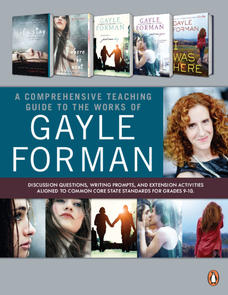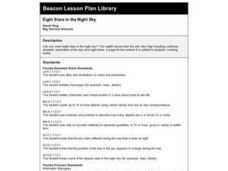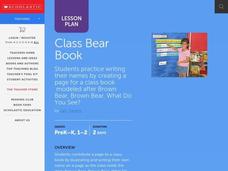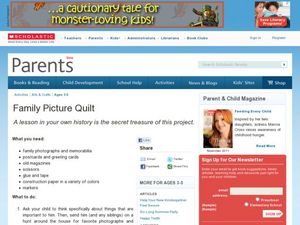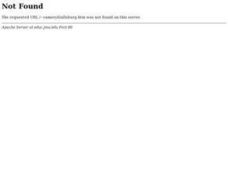Florida Center for Reading Research
Phonics: Letter- Sound Correspondence, Brown Bag It
Sorting objects according to their initial sound get scholars thinking about letter-sound correspondence. With 26 brown bags labeled with a letter of the alphabet, learners browse magazines and cut out images that begin with the...
Institute for Teaching through Technology and Innovative Practices
The Right Number of Elephants
How can you tell if a number of items is reasonable? Combine math and language arts with a fun lesson based on Jeff Shepard's The Right Number of Elephants. After reading the book, kids discuss amounts of other items and create minibooks...
J. Paul Getty Trust
Expressing Emotions through Art Lesson 1—Everyone Shows They Care
In a instructional activity that explores art and emotions, scholars analyze a piece of art and discuss which emotions it portrays. They go on to reflect on their own emotions and how they are similar to the feelings expressed...
Royal Conservatory of Music
The Anti-bullying Magazine
Get the word out about friendship, support, and a safe school community with a media literacy lesson about bullying. Young journalists investigate instances of bullying and take descriptive pictures as they compile a magazine to fight...
International Boys' Schools Coalition
Empathy
Putting yourself in someone else's shoes is a common phrase we hear from time to time, but do children really understand? Explore empathy with elementary schoolers using these activities. Focusing on feelings and emotions, students role...
Penguin Books
An Educator’s Guide to Gayle Forman
Sometimes a novel is the best way to tackle a tough topic. A helpful educator's guide for the novels of Gayle Forman discuss tough topics such as teenage suicide. Discussion questions and writing activities encourage readers to think...
Curated OER
Our Town by Thornton Wilder
In this online interactive reading comprehension instructional activity, students respond to 15 multiple choice questions about Wilder's Our Town. Students may submit their answers to be scored.
Curated OER
Eating the Food Pyramid
Students explore the concept of the Food Guide Pyramid. For this nutrition lesson, students discuss healthy eating habits after reading the book entitled Gregory, the Terrible Eater. Students then work in groups finding pictures of the...
Curated OER
Cleaning Day
Students read "Cleaning Day" by D. H. Figueredo. They predict what they would expect to see the father and child on the cover of the book doing, confirm their predictions after reading the story, and reflect on the relationship between...
Curated OER
Joseph Had a Little Overcoat
Students read the story Joseph Had a Little Overcoat about using a coat and making it into many things. In this reading lesson plan, students make a picture out of scraps and discuss how to reuse items to make new items.
Curated OER
10 Apples Up On Top
Stuents make class books as a follow up activity to the Dr. Seuss book Ten Apples Up On Top!
Curated OER
Jan Brett Encyclopedia Lesson
Third graders develop encyclopedia skills to locate information. In this Jan Brett library lesson, 3rd graders research animals in the encyclopedia and complete a worksheet on one animal. Students relate their work to the work of Jan...
Curated OER
Eight Stars in the Night Sky
First graders explore the day and night sky. They complete a number 8 page for their counting books.
Curated OER
Drawing Birds
First graders discuss what they know about birds and share picture books. They read text on the page and discuss the question and draw the flying bird on their paper by having them look at the color drawing of the bird.
Curated OER
The History of Maple Syrup
Students explore the process of harvesting maple syrup. In this science and history lesson, students make their own maple syrup and create a picture book that shows the Native American and American pioneer methods of making the syrup.
Curated OER
Guided Reading with I Had a Hippopotamus
Students discuss animals that would make good pets and a kind of pet that might scare someone in their family. They view the cover of the book and predict what the book might be about. They tell the story based on looking at the...
Curated OER
Splash
Students participate in a lesson that develops skills of reading comprehension. They work on the skills of using context and picture clues to derive meanings of words. The lesson concentrates on the high-frequency words of we, to,in, and...
Curated OER
Class Bear Book
Students discover writing their own name with the help of "Brown Bear, Brown Bear. What Do You See?" to create context for the activity. They create a page for a class book with the help of the teacher. The dialogue for the new book is...
Curated OER
Class Number Book
Students practice counting by ones. They find the numbers one through ten in a magazine or catalog. They put their picture into a classbook and they use it to practice counting.
Curated OER
Family Picture Quilt
Learners explore family backgrounds and traditions while discussing how memories are preserved. In this patchwork quilt activity, students create a keepsake by compiling pictures, drawings, and magazine clippings of things that are...
Houghton Mifflin Harcourt
Wheels Go Around: Challenge Activities (Theme 7)
Wheels go around is the theme of this series of challenge activities. Extend learning of making predictions and the reading comprehension skill, cause and effect, through grand conversations, poster designing, and writing books.
Curated OER
Butterfly, Butterfly: Teaching Vocabulary
Kindergarteners practice new words through listening to and reading the science book Butterfly by Jenny Feely. The teacher will first choose words that are essential for understanding the text. Then, using pictures in the text, pupils...
Houghton Mifflin Harcourt
Friends Together: Challenge Activities (Theme 4)
Friends are the overarching theme of this set of extension activities for more advanced learners. Kids complete a variety of different activities, such as putting together an alphabet book, writing about friends, creating books about...
Curated OER
Jumanji
Third graders read the book, Jumangi. Then they divide into groups of four or five and choose a habitat - desert, wetlands, Arctic/Antarctic, etc. Then each group can research the habitat to learn what kind of animals live there.







